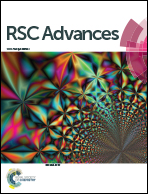Spontaneous growth of silver nanotrees dominated with (111) crystalline faces on monolithic activated carbon†
Abstract
An environmentally friendly wet chemistry approach is used to synthesize silver nanotrees with a single step. The silver nanotrees with single crystalline (111) faces were synthesized without any external reducing or stabilizing agents in water media, involving a galvanic-cell mechanism between the silver nanostructure and biomass-derived monolithic activated carbon (MAC). By varying the concentration of [Ag(NH3)2]NO3, silver nanoflowers, nanowires and nanorods can also be selectively obtained. The silver morphology can also be tuned by some anions such as PO43−, Cl− and OH− in MAC, which afford a more flexible morphological control in this galvanic-cell mechanism than those reported previously. Importantly, the obtained silver dendrites are found to yield excellent catalytic activity for the reduction of 4-nitroaniline by borohydride.


 Please wait while we load your content...
Please wait while we load your content...